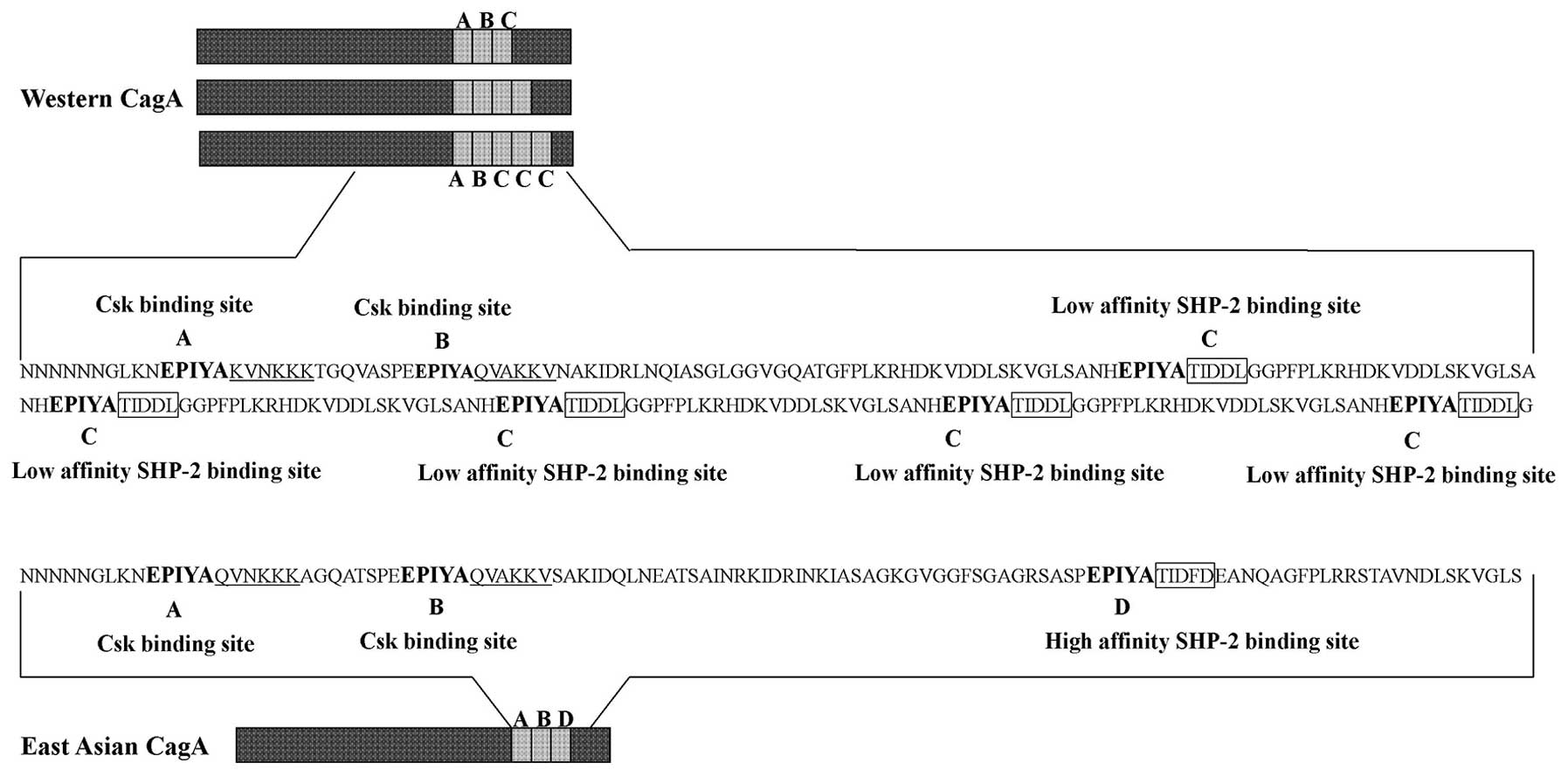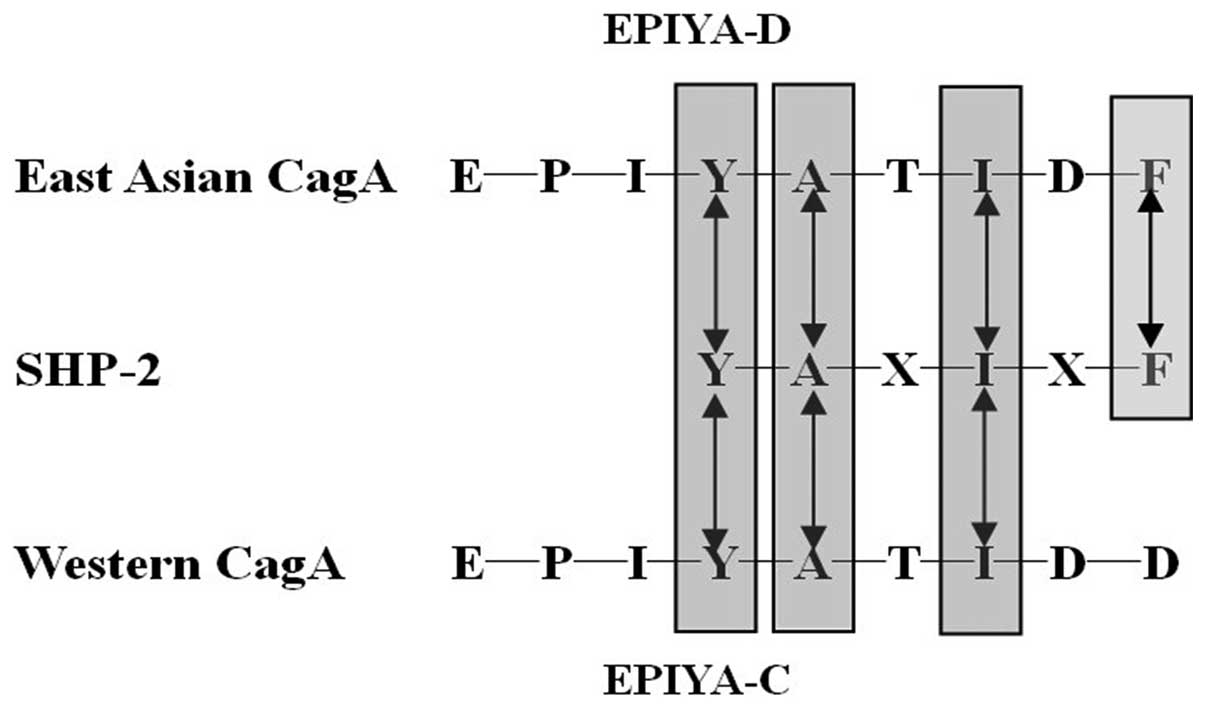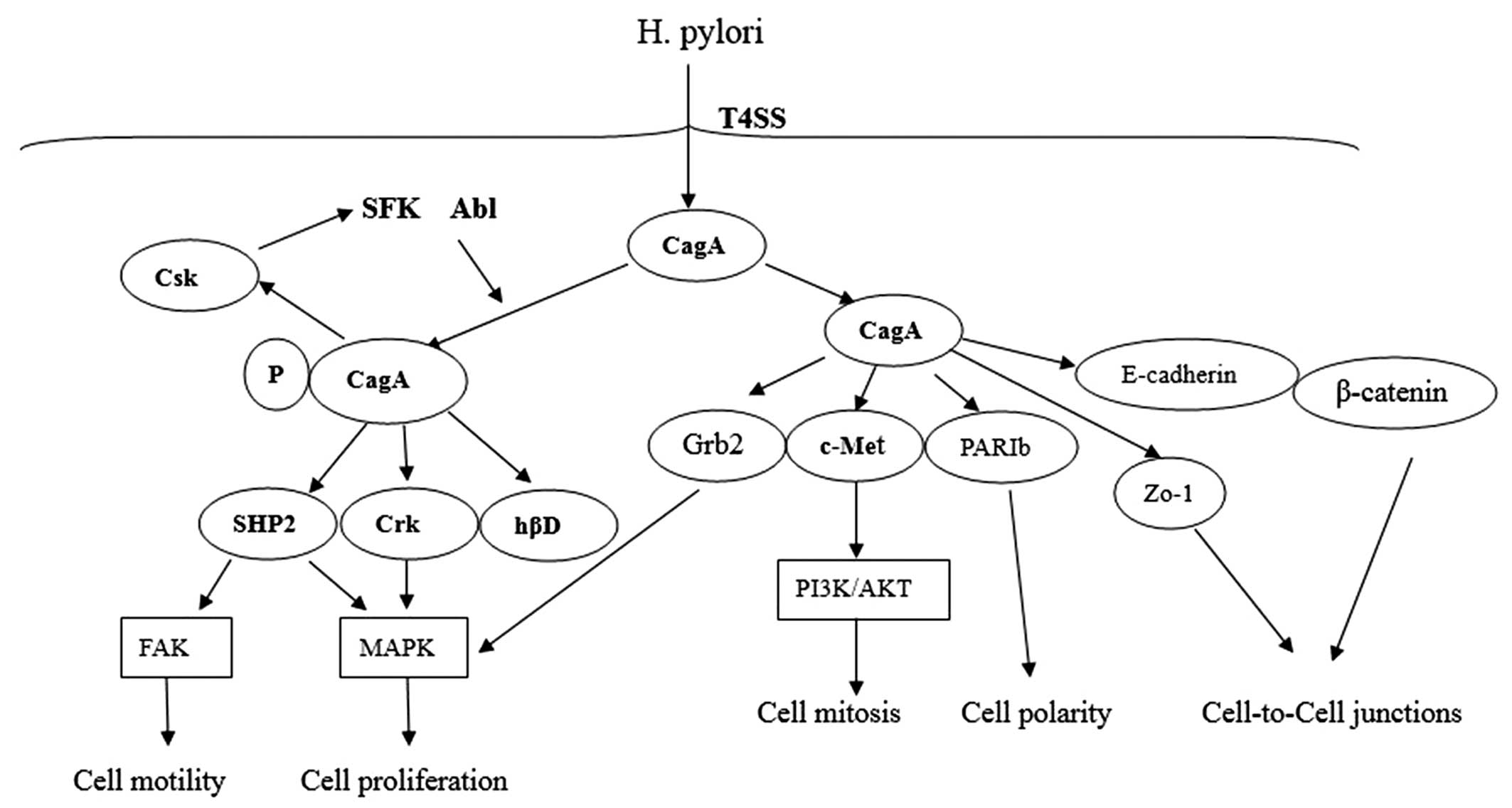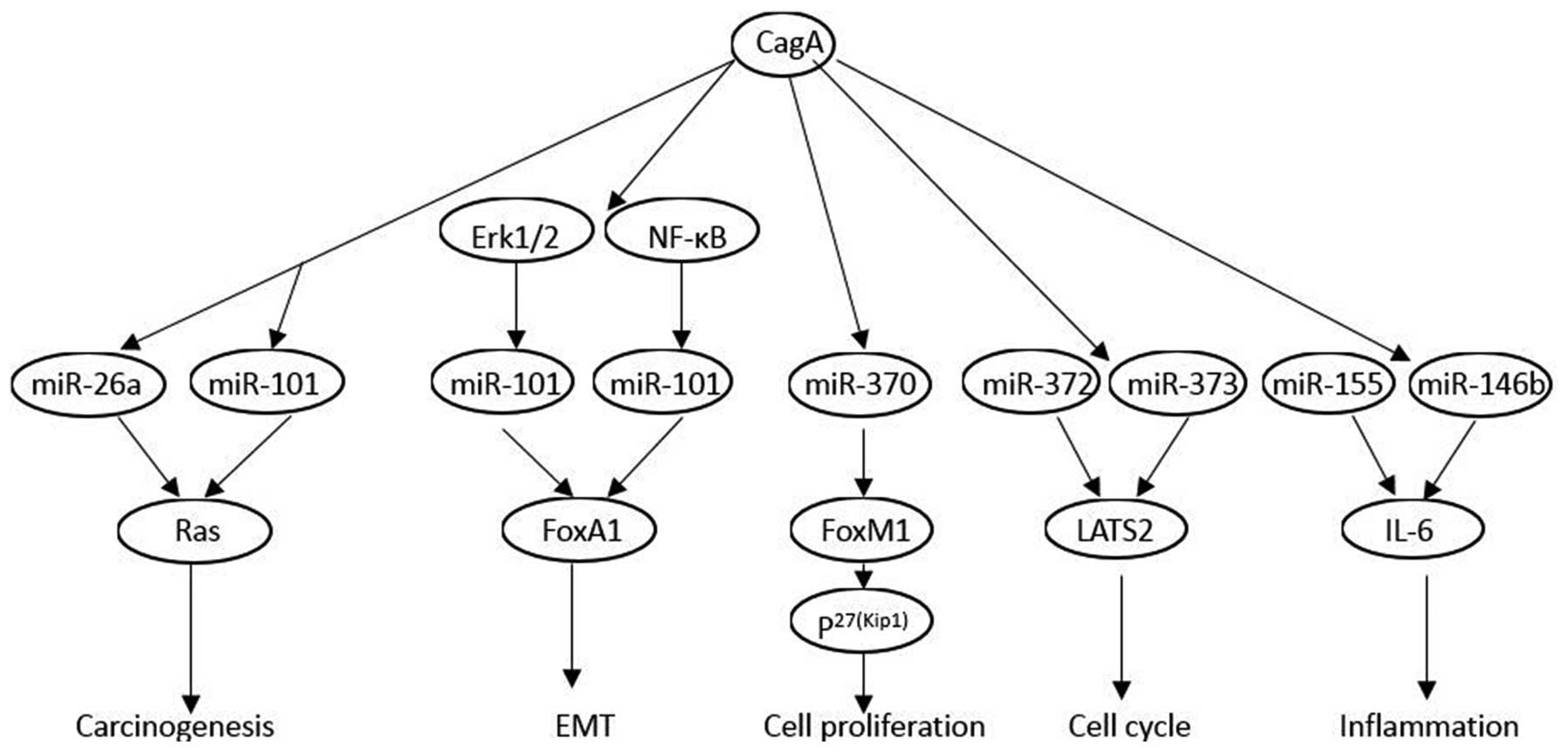Pathogenic mechanisms of the oncoprotein CagA in H. pylori-induced gastric cancer (Review)
- Authors:
- Shuai-Yin Chen
- Rong-Guang Zhang
- Guang-Cai Duan
-
Affiliations: Department of Epidemiology and Biostatistics, College of Public Health, Zhengzhou University, Zhengzhou, Henan 450001, P.R. China - Published online on: October 4, 2016 https://doi.org/10.3892/or.2016.5145
- Pages: 3087-3094
This article is mentioned in:
Abstract
 |
 |
 |
 |
|
Pacchiani N, Censini S, Buti L and Covacci A: Echoes of a distant past: The cag pathogenicity island of Helicobacter pylori. Cold Spring Harb Perspect Med. 3:a0103552013. View Article : Google Scholar : PubMed/NCBI | |
|
Cavaleiro-Pinto M, Peleteiro B, Lunet N and Barros H: Helicobacter pylori infection and gastric cardia cancer: Systematic review and meta-analysis. Cancer Causes Control. 22:375–387. 2011. View Article : Google Scholar : PubMed/NCBI | |
|
Akopyants NS, Clifton SW, Kersulyte D, Crabtree JE, Youree BE, Reece CA, Bukanov NO, Drazek ES, Roe BA and Berg DE: Analyses of the cag pathogenicity island of Helicobacter pylori. Mol Microbiol. 28:37–53. 1998. View Article : Google Scholar : PubMed/NCBI | |
|
Censini S, Lange C, Xiang Z, Crabtree JE, Ghiara P, Borodovsky M, Rappuoli R and Covacci A: cag, a pathogenicity island of Helicobacter pylori, encodes type I-specific and disease-associated virulence factors. Proc Natl Acad Sci USA. 93:14648–14653. 1996. View Article : Google Scholar : PubMed/NCBI | |
|
Yamaoka Y: Helicobacter pylori typing as a tool for tracking human migration. Clin Microbiol Infect. 15:829–834. 2009. View Article : Google Scholar : PubMed/NCBI | |
|
Lai CH, Perng CL, Lan KH and Lin HJ: Association of IS605 and cag-PAI of Helicobacter pylori isolated from patients with gastrointestinal diseases in Taiwan. Gastroenterol Res Pract. 2013:3562172013. View Article : Google Scholar : PubMed/NCBI | |
|
Torres J, Perez-Perez GI, Leal-Herrera Y and Munoz O: Infection with CagA+ Helicobacter pylori strains as a possible predictor of risk in the development of gastric adenocarcinoma in Mexico. Int J Cancer. 78:298–300. 1998. View Article : Google Scholar : PubMed/NCBI | |
|
Batista SA, Rocha GA, Rocha AM, Saraiva IE, Cabral MM, Oliveira RC and Queiroz DM: Higher number of Helicobacter pylori CagA EPIYA C phosphorylation sites increases the risk of gastric cancer, but not duodenal ulcer. BMC Microbiol. 11:612011. View Article : Google Scholar : PubMed/NCBI | |
|
Franco AT, Johnston E, Krishna U, Yamaoka Y, Israel DA, Nagy TA, Wroblewski LE, Piazuelo MB, Correa P and Peek RM Jr: Regulation of gastric carcinogenesis by Helicobacter pylori virulence factors. Cancer Res. 68:379–387. 2008. View Article : Google Scholar : PubMed/NCBI | |
|
Ohnishi N, Yuasa H, Tanaka S, Sawa H, Miura M, Matsui A, Higashi H, Musashi M, Iwabuchi K, Suzuki M, et al: Transgenic expression of Helicobacter pylori CagA induces gastrointestinal and hematopoietic neoplasms in mouse. Proc Natl Acad Sci USA. 105:1003–1008. 2008. View Article : Google Scholar : PubMed/NCBI | |
|
Backert S, Tegtmeyer N and Fischer W: Composition, structure and function of the Helicobacter pylori cag pathogenicity island encoded type IV secretion system. Future Microbiol. 10:955–965. 2015. View Article : Google Scholar : PubMed/NCBI | |
|
Tegtmeyer N, Hartig R, Delahay RM, Rohde M, Brandt S, Conradi J, Takahashi S, Smolka AJ, Sewald N and Backert S: A small fibronectin-mimicking protein from bacteria induces cell spreading and focal adhesion formation. J Biol Chem. 285:23515–23526. 2010. View Article : Google Scholar : PubMed/NCBI | |
|
Murata-Kamiya N, Kikuchi K, Hayashi T, Higashi H and Hatakeyama M: Helicobacter pylori exploits host membrane phosphatidylserine for delivery, localization, and pathophysiological action of the CagA oncoprotein. Cell Host Microbe. 7:399–411. 2010. View Article : Google Scholar : PubMed/NCBI | |
|
Fischer W: Assembly and molecular mode of action of the Helicobacter pylori Cag type IV secretion apparatus. FEBS J. 278:1203–1212. 2011. View Article : Google Scholar : PubMed/NCBI | |
|
Gopal GJ, Pal J, Kumar A and Mukhopadhyay G: C-terminal domain of CagX is responsible for its interaction with CagT protein of Helicobacter pylori type IV secretion system. Biochem Biophys Res Commun. 456:98–103. 2015. View Article : Google Scholar : PubMed/NCBI | |
|
Shariq M, Kumar N, Kumari R, Kumar A, Subbarao N and Mukhopadhyay G: Biochemical analysis of CagE: A VirB4 homologue of Helicobacter pylori Cag-T4SS. PLoS One. 10:e01426062015. View Article : Google Scholar : PubMed/NCBI | |
|
Odenbreit S, Püls J, Sedlmaier B, Gerland E, Fischer W and Haas R: Translocation of Helicobacter pylori CagA into gastric epithelial cells by type IV secretion. Science. 287:1497–1500. 2000. View Article : Google Scholar : PubMed/NCBI | |
|
Schindele F, Weiss E, Haas R and Fischer W: Quantitative analysis of CagA type IV secretion by Helicobacter pylori reveals substrate recognition and translocation requirements. Mol Microbiol. 100:188–203. 2016. View Article : Google Scholar : PubMed/NCBI | |
|
Stein M, Bagnoli F, Halenbeck R, Rappuoli R, Fantl WJ and Covacci A: c-Src/Lyn kinases activate Helicobacter pylori CagA through tyrosine phosphorylation of the EPIYA motifs. Mol Microbiol. 43:971–980. 2002. View Article : Google Scholar : PubMed/NCBI | |
|
Tegtmeyer N and Backert S: Role of Abl and Src family kinases in actin-cytoskeletal rearrangements induced by the Helicobacter pylori CagA protein. Eur J Cell Biol. 90:880–890. 2011. View Article : Google Scholar : PubMed/NCBI | |
|
Tammer I, Brandt S, Hartig R, König W and Backert S: Activation of Abl by Helicobacter pylori: A novel kinase for CagA and crucial mediator of host cell scattering. Gastroenterology. 132:1309–1319. 2007. View Article : Google Scholar : PubMed/NCBI | |
|
Zhu Y-L, Zheng S, Du Q, Qian K-D and Fang P-C: Characterization of CagA variable region of Helicobacter pylori isolates from Chinese patients. World J Gastroenterol. 11:880–884. 2005. View Article : Google Scholar : PubMed/NCBI | |
|
Vaziri F, Peerayeh SN, Alebouyeh M, Maghsoudi N, Azimzadeh P, Siadat SD and Zali MR: Novel effects of Helicobacter pylori CagA on key genes of gastric cancer signal transduction: A comparative transfection study. Pathog Dis. 73:ftu0212015. View Article : Google Scholar : PubMed/NCBI | |
|
Zhang XS, Tegtmeyer N, Traube L, Jindal S, Perez-Perez G, Sticht H, Backert S and Blaser MJ: A specific A/T polymorphism in Western tyrosine phosphorylation B-motifs regulates Helicobacter pylori CagA epithelial cell interactions. PLoS Pathog. 11:e10046212015. View Article : Google Scholar : PubMed/NCBI | |
|
Ferreira RM, Machado JC, Leite M, Carneiro F and Figueiredo C: The number of Helicobacter pylori CagA EPIYA C tyrosine phosphorylation motifs influences the pattern of gastritis and the development of gastric carcinoma. Histopathology. 60:992–998. 2012. View Article : Google Scholar : PubMed/NCBI | |
|
Higashi H, Tsutsumi R, Fujita A, Yamazaki S, Asaka M, Azuma T and Hatakeyama M: Biological activity of the Helicobacter pylori virulence factor CagA is determined by variation in the tyrosine phosphorylation sites. Proc Natl Acad Sci USA. 99:14428–14433. 2002. View Article : Google Scholar : PubMed/NCBI | |
|
Monstein H-J, Karlsson A, Ryberg A and Borch K: Application of PCR amplicon sequencing using a single primer pair in PCR amplification to assess variations in Helicobacter pylori CagA EPIYA tyrosine phosphorylation motifs. BMC Res Notes. 3:352010. View Article : Google Scholar : PubMed/NCBI | |
|
De Souza D, Fabri LJ, Nash A, Hilton DJ, Nicola NA and Baca M: SH2 domains from suppressor of cytokine signaling-3 and protein tyrosine phosphatase SHP-2 have similar binding specificities. Biochemistry. 41:9229–9236. 2002. View Article : Google Scholar : PubMed/NCBI | |
|
Mueller D, Tegtmeyer N, Brandt S, Yamaoka Y, De Poire E, Sgouras D, Wessler S, Torres J, Smolka A and Backert S: c-Src and c-Abl kinases control hierarchic phosphorylation and function of the CagA effector protein in Western and East Asian Helicobacter pylori strains. J Clin Invest. 122:1553–1566. 2012. View Article : Google Scholar : PubMed/NCBI | |
|
Ren S, Higashi H, Lu H, Azuma T and Hatakeyama M: Structural basis and functional consequence of Helicobacter pylori CagA multimerization in cells. J Biol Chem. 281:32344–32352. 2006. View Article : Google Scholar : PubMed/NCBI | |
|
Yamazaki S, Yamakawa A, Ito Y, Ohtani M, Higashi H, Hatakeyama M and Azuma T: The CagA protein of Helicobacter pylori is translocated into epithelial cells and binds to SHP-2 in human gastric mucosa. J Infect Dis. 187:334–337. 2003. View Article : Google Scholar : PubMed/NCBI | |
|
Montagner A, Yart A, Dance M, Perret B, Salles JP and Raynal P: A novel role for Gab1 and SHP2 in epidermal growth factor-induced Ras activation. J Biol Chem. 280:5350–5360. 2005. View Article : Google Scholar : PubMed/NCBI | |
|
Higashi H, Nakaya A, Tsutsumi R, Yokoyama K, Fujii Y, Ishikawa S, Higuchi M, Takahashi A, Kurashima Y, Teishikata Y, et al: Helicobacter pylori CagA induces Ras-independent morphogenetic response through SHP-2 recruitment and activation. J Biol Chem. 279:17205–17216. 2004. View Article : Google Scholar : PubMed/NCBI | |
|
Tsutsumi R, Takahashi A, Azuma T, Higashi H and Hatakeyama M: Focal adhesion kinase is a substrate and downstream effector of SHP-2 complexed with Helicobacter pylori CagA. Mol Cell Biol. 26:261–276. 2006. View Article : Google Scholar : PubMed/NCBI | |
|
Tsutsumi R, Higashi H, Higuchi M, Okada M and Hatakeyama M: Attenuation of Helicobacter pylori CagA × SHP-2 signaling by interaction between CagA and C-terminal Src kinase. J Biol Chem. 278:3664–3670. 2003. View Article : Google Scholar : PubMed/NCBI | |
|
Suzuki M, Mimuro H, Suzuki T, Park M, Yamamoto T and Sasakawa C: Interaction of CagA with Crk plays an important role in Helicobacter pylori-induced loss of gastric epithelial cell adhesion. J Exp Med. 202:1235–1247. 2005. View Article : Google Scholar : PubMed/NCBI | |
|
Bauer B, Pang E, Holland C, Kessler M, Bartfeld S and Meyer TF: The Helicobacter pylori virulence effector CagA abrogates human β-defensin 3 expression via inactivation of EGFR signaling. Cell Host Microbe. 11:576–586. 2012. View Article : Google Scholar : PubMed/NCBI | |
|
Patel SR, Smith K, Letley DP, Cook KW, Memon AA, Ingram RJ, Staples E, Backert S, Zaitoun AM, Atherton JC, et al: Helicobacter pylori downregulates expression of human β-defensin 1 in the gastric mucosa in a type IV secretion-dependent fashion. Cell Microbiol. 15:2080–2092. 2013. View Article : Google Scholar : PubMed/NCBI | |
|
Churin Y, Al-Ghoul L, Kepp O, Meyer TF, Birchmeier W and Naumann M: Helicobacter pylori CagA protein targets the c-Met receptor and enhances the motogenic response. J Cell Biol. 161:249–255. 2003. View Article : Google Scholar : PubMed/NCBI | |
|
Suzuki M, Mimuro H, Kiga K, Fukumatsu M, Ishijima N, Morikawa H, Nagai S, Koyasu S, Gilman RH, Kersulyte D, et al: Helicobacter pylori CagA phosphorylation-independent function in epithelial proliferation and inflammation. Cell Host Microbe. 5:23–34. 2009. View Article : Google Scholar : PubMed/NCBI | |
|
Mimuro H, Suzuki T, Tanaka J, Asahi M, Haas R and Sasakawa C: Grb2 is a key mediator of Helicobacter pylori CagA protein activities. Mol Cell. 10:745–755. 2002. View Article : Google Scholar : PubMed/NCBI | |
|
Amieva MR, Vogelmann R, Covacci A, Tompkins LS, Nelson WJ and Falkow S: Disruption of the epithelial apical-junctional complex by Helicobacter pylori CagA. Science. 300:1430–1434. 2003. View Article : Google Scholar : PubMed/NCBI | |
|
Murata-Kamiya N, Kurashima Y, Teishikata Y, Yamahashi Y, Saito Y, Higashi H, Aburatani H, Akiyama T, Peek RM Jr, Azuma T, et al: Helicobacter pylori CagA interacts with E-cadherin and deregulates the β-catenin signal that promotes intestinal transdifferentiation in gastric epithelial cells. Oncogene. 26:4617–4626. 2007. View Article : Google Scholar : PubMed/NCBI | |
|
Neal JT, Peterson TS, Kent ML and Guillemin K: H. pylori virulence factor CagA increases intestinal cell proliferation by Wnt pathway activation in a transgenic zebrafish model. Dis Model Mech. 6:802–810. 2013. View Article : Google Scholar : PubMed/NCBI | |
|
Oliveira MJ, Costa AM, Costa AC, Ferreira RM, Sampaio P, Machado JC, Seruca R, Mareel M and Figueiredo C: CagA associates with c-Met, E-cadherin, and p120-catenin in a multiproteic complex that suppresses Helicobacter pylori-induced cell-invasive phenotype. J Infect Dis. 200:745–755. 2009. View Article : Google Scholar : PubMed/NCBI | |
|
Kurashima Y, Murata-Kamiya N, Kikuchi K, Higashi H, Azuma T, Kondo S and Hatakeyama M: Deregulation of beta-catenin signal by Helicobacter pylori CagA requires the CagA-multimerization sequence. Int J Cancer. 122:823–831. 2008. View Article : Google Scholar : PubMed/NCBI | |
|
Saadat I, Higashi H, Obuse C, Umeda M, Murata-Kamiya N, Saito Y, Lu H, Ohnishi N, Azuma T, Suzuki A, et al: Helicobacter pylori CagA targets PAR1/MARK kinase to disrupt epithelial cell polarity. Nature. 447:330–333. 2007. View Article : Google Scholar : PubMed/NCBI | |
|
Goldstein B and Macara IG: The PAR proteins: Fundamental players in animal cell polarization. Dev Cell. 13:609–622. 2007. View Article : Google Scholar : PubMed/NCBI | |
|
Suzuki A and Ohno S: The PAR-aPKC system: Lessons in polarity. J Cell Sci. 119:979–987. 2006. View Article : Google Scholar : PubMed/NCBI | |
|
Lu HS, Saito Y, Umeda M, Murata-Kamiya N, Zhang HM, Higashi H and Hatakeyama M: Structural and functional diversity in the PAR1b/MARK2-binding region of Helicobacter pylori CagA. Cancer Sci. 99:2004–2011. 2008.PubMed/NCBI | |
|
Lu H, Murata-Kamiya N, Saito Y and Hatakeyama M: Role of partitioning-defective 1/microtubule affinity-regulating kinases in the morphogenetic activity of Helicobacter pylori CagA. J Biol Chem. 284:23024–23036. 2009. View Article : Google Scholar : PubMed/NCBI | |
|
Zeaiter Z, Cohen D, Müsch A, Bagnoli F, Covacci A and Stein M: Analysis of detergent-resistant membranes of Helicobacter pylori infected gastric adenocarcinoma cells reveals a role for MARK2/Par1b in CagA-mediated disruption of cellular polarity. Cell Microbiol. 10:781–794. 2008. View Article : Google Scholar : PubMed/NCBI | |
|
Yamahashi Y and Hatakeyama M: PAR1b takes the stage in the morphogenetic and motogenetic activity of Helicobacter pylori CagA oncoprotein. Cell Adhes Migr. 7:11–18. 2013. View Article : Google Scholar | |
|
Suzuki N, Murata-Kamiya N, Yanagiya K, Suda W, Hattori M, Kanda H, Bingo A, Fujii Y, Maeda S, Koike K, et al: Mutual reinforcement of inflammation and carcinogenesis by the Helicobacter pylori CagA oncoprotein. Sci Rep. 5:100242015. View Article : Google Scholar : PubMed/NCBI | |
|
Mishra JP, Cohen D, Zamperone A, Nesic D, Muesch A and Stein M: CagA of Helicobacter pylori interacts with and inhibits the serine-threonine kinase PRK2. Cell Microbiol. 17:1670–1682. 2015. View Article : Google Scholar : PubMed/NCBI | |
|
Sandoval J and Esteller M: Cancer epigenomics: Beyond genomics. Curr Opin Genet Dev. 22:50–55. 2012. View Article : Google Scholar : PubMed/NCBI | |
|
Verma M: The role of epigenomics in the study of cancer biomarkers and in the development of diagnostic tools. Adv Exp Med Biol. 867:59–80. 2015. View Article : Google Scholar : PubMed/NCBI | |
|
Hernando-Herraez I, Garcia-Perez R, Sharp AJ and Marques-Bonet T: DNA methylation: Insights into human evolution. PLoS Genet. 11:e10056612015. View Article : Google Scholar : PubMed/NCBI | |
|
Maekita T, Nakazawa K, Mihara M, Nakajima T, Yanaoka K, Iguchi M, Arii K, Kaneda A, Tsukamoto T, Tatematsu M, et al: High levels of aberrant DNA methylation in Helicobacter pylori-infected gastric mucosae and its possible association with gastric cancer risk. Clin Cancer Res. 12:989–995. 2006. View Article : Google Scholar : PubMed/NCBI | |
|
Yoshida T, Kato J, Maekita T, Yamashita S, Enomoto S, Ando T, Niwa T, Deguchi H, Ueda K, Inoue I, et al: Altered mucosal DNA methylation in parallel with highly active Helicobacter pylori-related gastritis. Gastric Cancer. 16:488–497. 2013. View Article : Google Scholar : PubMed/NCBI | |
|
Tomita H, Takaishi S, Menheniott TR, Yang X, Shibata W, Jin G, Betz KS, Kawakami K, Minamoto T and Tomasetto C: Inhibition of gastric carcinogenesis by the hormone gastrin is mediated by suppression of TFF1 epigenetic silencing. Gastroenterology. 140:879–891. 2011. View Article : Google Scholar : PubMed/NCBI | |
|
Guo XB, Guo L, Zhi QM, Ji J, Jiang JL, Zhang RJ, Zhang JN, Zhang J, Chen XH, Cai Q, et al: Helicobacter pylori induces promoter hypermethylation and downregulates gene expression of IRX1 transcription factor on human gastric mucosa. J Gastroenterol Hepatol. 26:1685–1690. 2011. View Article : Google Scholar : PubMed/NCBI | |
|
Hayashi Y, Tsujii M, Wang J, Kondo J, Akasaka T, Jin Y, Li W, Nakamura T, Nishida T, Iijima H, et al: CagA mediates epigenetic regulation to attenuate let-7 expression in Helicobacter pylori-related carcinogenesis. Gut. 62:1536–1546. 2013. View Article : Google Scholar : PubMed/NCBI | |
|
Zhang YW, Eom SY, Yim DH, Song YJ, Yun HY, Park JS, Youn SJ, Kim BS, Kim YD and Kim H: Evaluation of the relationship between dietary factors, CagA-positive Helicobacter pylori infection, and RUNX3 promoter hypermethylation in gastric cancer tissue. World J Gastroenterol. 19:1778–1787. 2013. View Article : Google Scholar : PubMed/NCBI | |
|
He L and Hannon GJ: MicroRNAs: Small RNAs with a big role in gene regulation. Nat Rev Genet. 5:522–531. 2004. View Article : Google Scholar : PubMed/NCBI | |
|
Xiao C and Rajewsky K: MicroRNA control in the immune system: Basic principles. Cell. 136:26–36. 2009. View Article : Google Scholar : PubMed/NCBI | |
|
Libânio D, Dinis-Ribeiro M and Pimentel-Nunes P: Helicobacter pylori and microRNAs: Relation with innate immunity and progression of preneoplastic conditions. World J Clin Oncol. 6:111–132. 2015. View Article : Google Scholar : PubMed/NCBI | |
|
Noto JM and Peek RM: The role of microRNAs in Helicobacter pylori pathogenesis and gastric carcinogenesis. Front Cell Infect Microbiol. 1:212012. View Article : Google Scholar : PubMed/NCBI | |
|
Matsushima K, Isomoto H, Inoue N, Nakayama T, Hayashi T, Nakayama M, Nakao K, Hirayama T and Kohno S: MicroRNA signatures in Helicobacter pylori-infected gastric mucosa. Int J Cancer. 128:361–370. 2011. View Article : Google Scholar : PubMed/NCBI | |
|
Zhu Y, Jiang Q, Lou X, Ji X, Wen Z, Wu J, Tao H, Jiang T, He W, Wang C, et al: MicroRNAs up-regulated by CagA of Helicobacter pylori induce intestinal metaplasia of gastric epithelial cells. PLoS One. 7:e351472012. View Article : Google Scholar : PubMed/NCBI | |
|
Feng Y, Wang L, Zeng J, Shen L, Liang X, Yu H, Liu S, Liu Z, Sun Y, Li W, et al: FoxM1 is overexpressed in Helicobacter pylori-induced gastric carcinogenesis and is negatively regulated by miR-370. Mol Cancer Res. 11:834–844. 2013. View Article : Google Scholar : PubMed/NCBI | |
|
Li N, Tang B, Zhu ED, Li BS, Zhuang Y, Yu S, Lu DS, Zou QM, Xiao B and Mao XH: Increased miR-222 in H. pylori-associated gastric cancer correlated with tumor progression by promoting cancer cell proliferation and targeting RECK. FEBS Lett. 586:722–728. 2012. View Article : Google Scholar : PubMed/NCBI | |
|
Belair C, Baud J, Chabas S, Sharma CM, Vogel J, Staedel C and Darfeuille F: Helicobacter pylori interferes with an embryonic stem cell micro RNA cluster to block cell cycle progression. Silence. 2:72011. View Article : Google Scholar : PubMed/NCBI | |
|
Cheng SF, Li L and Wang LM: miR-155 and miR-146b negatively regulates IL6 in Helicobacter pylori (cagA+) infected gastroduodenal ulcer. Eur Rev Med Pharmacol Sci. 19:607–613. 2015.PubMed/NCBI | |
|
Harr JC, Gonzalez-Sandoval A and Gasser SM: Histones and histone modifications in perinuclear chromatin anchoring: From yeast to man. EMBO Rep. 17:139–155. 2016. View Article : Google Scholar : PubMed/NCBI | |
|
Schones DE, Cui K, Cuddapah S, Roh TY, Barski A, Wang Z, Wei G and Zhao K: Dynamic regulation of nucleosome positioning in the human genome. Cell. 132:887–898. 2008. View Article : Google Scholar : PubMed/NCBI | |
|
Xia G, Schneider-Stock R, Diestel A, Habold C, Krueger S, Roessner A, Naumann M and Lendeckel U: Helicobacter pylori regulates p21 (WAF1) by histone H4 acetylation. Biochem Biophys Res Commun. 369:526–531. 2008. View Article : Google Scholar : PubMed/NCBI | |
|
Fehri LF, Rechner C, Janssen S, Mak TN, Holland C, Bartfeld S, Brüggemann H and Meyer TF: Helicobacter pylori-induced modification of the histone H3 phosphorylation status in gastric epithelial cells reflects its impact on cell cycle regulation. Epigenetics. 4:577–586. 2009. View Article : Google Scholar : PubMed/NCBI | |
|
Liang X, Zeng J, Wang L, Shen L, Li S, Ma L, Ci X, Yu J, Jia M, Sun Y, et al: Histone demethylase RBP2 induced by Helicobactor pylori CagA participates in the malignant transformation of gastric epithelial cells. Oncotarget. 5:5798–5807. 2014. View Article : Google Scholar : PubMed/NCBI |









